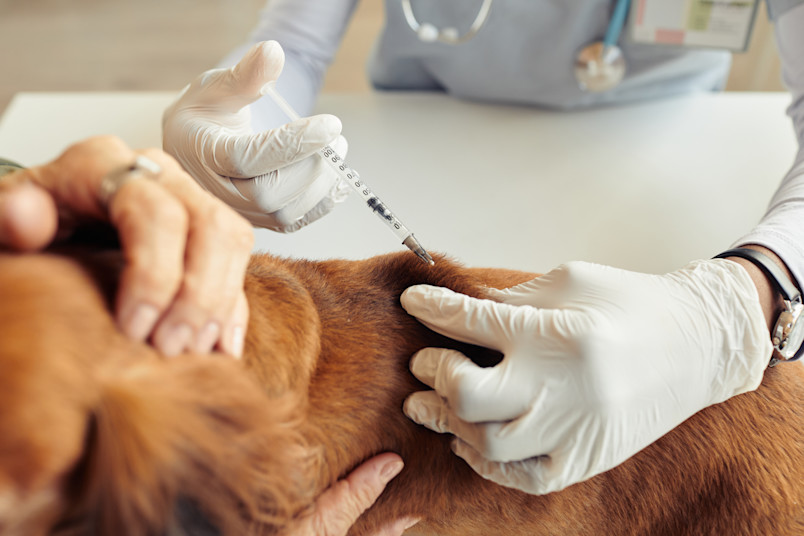
Splashing in puddles, chasing squirrels – it's all part of the joy of being a dog. Who doesn't love seeing their furry friend revel in the simple pleasures of the outdoors? But playtime can take an unexpected turn with leptospirosis, a bacterial disease spread by wild animals.
You’re probably familiar with a few of the diseases that your dog is commonly vaccinated for, mainly parvo and distemper. But you may want to add leptospirosis to your dog’s vaccination list. The leptospirosis vaccine helps protect dogs from getting a bacterial infection from Leptospira, something that can affect humans as well. Vaccination is the best way to prevent this issue.
What Causes Leptospirosis and How Do Dogs Get It?
There are many strains of the Leptospira bacteria, and they all like to live where it’s warm and wet, so think slow or non-moving water, like lakes, ponds, streams, and even large puddles. Wildlife, such as rodents, raccoons, and deer can carry this organism and pass it in their urine. This means that anytime your dog encounters infected animal urine, they’re at risk of catching leptospirosis. While most people would assume that only dogs that go out in the forest would be exposed, it can happen to any dog as wildlife often frequent yards, lawns, or parks in town. As we all know, animals such as squirrels and mice are common in every backyard and every city park (and sidewalk!).
What Are the Signs of Leptospirosis in Dogs?
Once Leptospira bacteria get into a dog’s body, they go immediately for the blood vessels. There, they can travel throughout the body, potentially creating all kinds of problems in organs such as the liver and kidneys. Signs can be very nonspecific, but can include:
Fever
Lethargy
Weakness
Decreased appetite
Stiffness
Increased drinking/urinating
Yellow eyes or skin (jaundice)
These are common signs for a lot of illnesses, so seeing a veterinarian anytime something is a little off with your dog is important.
How is Lepto Diagnosed and Treated?
Since the signs of lepto may cross over with other illnesses, they aren’t enough for a diagnosis. Instead, your vet will need to take vaccination status into account and run further tests. These may include blood work and a urinalysis or repeated serological tests to check for antibodies to lepto or PCR to find Leptospira DNA. Sometimes veterinarians may need to treat without a definitive diagnosis.
Treating Leptospirosis
The infection is then treated with a long course of antibiotics, most commonly doxycycline and penicillin. Dogs will need to be treated for at least two weeks to make sure they clear the infection and don’t become carriers that can unknowingly pass the disease on to other dogs. Dogs may need additional supportive care, such as fluids, anti-nausea and anti-vomit medications as well. Some pups may require hospitalization and intensive therapy to help support kidneys or the liver.
How Can You Prevent Leptospirosis in Dogs?
Since you now know that lepto likes to hang out in water and is passed by wildlife, you can do your best to avoid these areas and keep your dog from drinking out of these water sources. However, since wildlife often encroach on areas frequently used by dogs, this may not always work. So, to boost a dog’s protection against lepto, they should receive the leptospirosis vaccine.

What is the Lepto Vaccine for Dogs?
Vaccinating for lepto isn’t considered part of the core vaccines that every dog should get. Instead, it falls into the non-core category, similar to the Lyme disease vaccine in dogs, to be used for dogs that are most at risk. As you can imagine, dogs that live in wet environments, especially with lots of interaction with wildlife are prime candidates, but all dogs should be considered.
The leptospirosis vaccine is a little different than other dog vaccines. It can be given as part of the regular combination shot containing distemper, parvo, parainfluenza and adenovirus, but it really should be boostered yearly, especially for those at-risk dogs. In my area, we recommend lepto vaccines for all dogs every year. This vaccine helps protect against four of the most common strains of Leptospira.
As you can imagine, an annual booster will increase costs of how much dogs shots cost per year, but it’s well worth it when you consider what the cost to treat the disease may be. Having pet health insurance can be vital if you end up with a leptospirosis infection, but pet insurance doesn’t cover preventative medicine, so you’ll need a flexible pet wellness plan to budget for those vaccine expenses.
Leptospirosis Precautions for Pet Owners
Since leptospirosis can affect humans, you need to be careful as well. This means keeping your hands out of your dog’s urine and out of potentially contaminated water. Wear gloves to do yard work and wash your hands frequently while playing with your dog or when out in nature. Also, be sure to see a doctor if you aren’t feeling well.
Protecting Your Dog from Leptospirosis
Leptospirosis is out there in many areas of the United States. While wildlife transmit the disease, it isn’t limited to dogs that frequently explore nature. Any dog can be at risk. So, be sure to ask your veterinarian about the leptospirosis vaccine, keep your yard and pet’s outdoor area free from water and wildlife, if possible, and get them covered by pet insurance to help with all types of expenses.